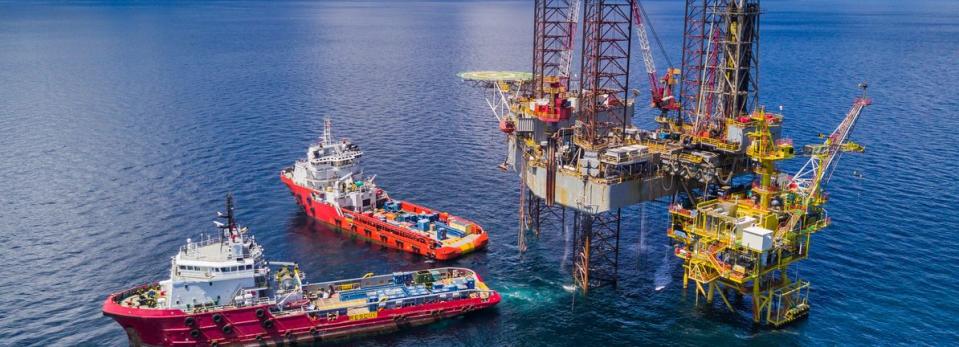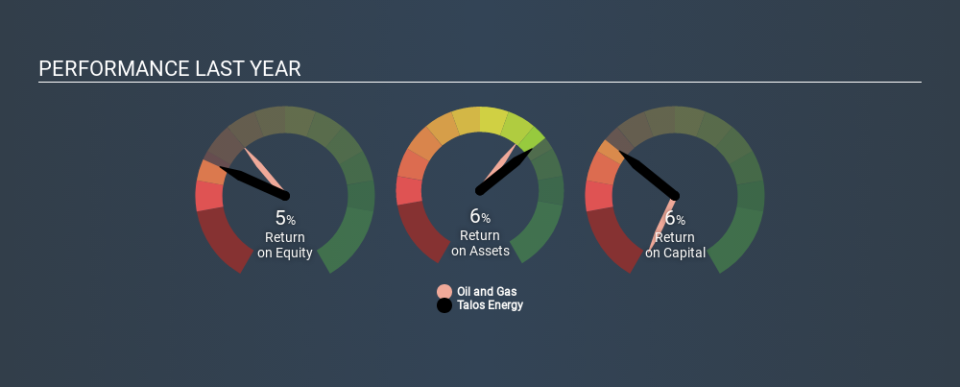Are Talos Energy Inc.’s Returns On Capital Worth Investigating?

Today we'll evaluate Talos Energy Inc. (NYSE:TALO) to determine whether it could have potential as an investment idea. Specifically, we'll consider its Return On Capital Employed (ROCE), since that will give us an insight into how efficiently the business can generate profits from the capital it requires.
Firstly, we'll go over how we calculate ROCE. Then we'll compare its ROCE to similar companies. Last but not least, we'll look at what impact its current liabilities have on its ROCE.
What is Return On Capital Employed (ROCE)?
ROCE is a metric for evaluating how much pre-tax income (in percentage terms) a company earns on the capital invested in its business. Generally speaking a higher ROCE is better. Overall, it is a valuable metric that has its flaws. Author Edwin Whiting says to be careful when comparing the ROCE of different businesses, since 'No two businesses are exactly alike.
How Do You Calculate Return On Capital Employed?
The formula for calculating the return on capital employed is:
Return on Capital Employed = Earnings Before Interest and Tax (EBIT) ÷ (Total Assets - Current Liabilities)
Or for Talos Energy:
0.059 = US$130m ÷ (US$2.6b - US$370m) (Based on the trailing twelve months to December 2019.)
So, Talos Energy has an ROCE of 5.9%.
See our latest analysis for Talos Energy
Is Talos Energy's ROCE Good?
When making comparisons between similar businesses, investors may find ROCE useful. Using our data, Talos Energy's ROCE appears to be around the 6.8% average of the Oil and Gas industry. Separate from how Talos Energy stacks up against its industry, its ROCE in absolute terms is mediocre; relative to the returns on government bonds. Readers may find more attractive investment prospects elsewhere.
Talos Energy has an ROCE of 5.9%, but it didn't have an ROCE 3 years ago, since it was unprofitable. This makes us wonder if the company is improving. You can see in the image below how Talos Energy's ROCE compares to its industry. Click to see more on past growth.
Remember that this metric is backwards looking - it shows what has happened in the past, and does not accurately predict the future. ROCE can be misleading for companies in cyclical industries, with returns looking impressive during the boom times, but very weak during the busts. This is because ROCE only looks at one year, instead of considering returns across a whole cycle. We note Talos Energy could be considered a cyclical business. What happens in the future is pretty important for investors, so we have prepared a free report on analyst forecasts for Talos Energy.
Do Talos Energy's Current Liabilities Skew Its ROCE?
Current liabilities are short term bills and invoices that need to be paid in 12 months or less. The ROCE equation subtracts current liabilities from capital employed, so a company with a lot of current liabilities appears to have less capital employed, and a higher ROCE than otherwise. To counteract this, we check if a company has high current liabilities, relative to its total assets.
Talos Energy has current liabilities of US$370m and total assets of US$2.6b. Therefore its current liabilities are equivalent to approximately 14% of its total assets. This very reasonable level of current liabilities would not boost the ROCE by much.
What We Can Learn From Talos Energy's ROCE
That said, Talos Energy's ROCE is mediocre, there may be more attractive investments around. You might be able to find a better investment than Talos Energy. If you want a selection of possible winners, check out this free list of interesting companies that trade on a P/E below 20 (but have proven they can grow earnings).
For those who like to find winning investments this free list of growing companies with recent insider purchasing, could be just the ticket.
If you spot an error that warrants correction, please contact the editor at editorial-team@simplywallst.com. This article by Simply Wall St is general in nature. It does not constitute a recommendation to buy or sell any stock, and does not take account of your objectives, or your financial situation. Simply Wall St has no position in the stocks mentioned.
We aim to bring you long-term focused research analysis driven by fundamental data. Note that our analysis may not factor in the latest price-sensitive company announcements or qualitative material. Thank you for reading.

 Yahoo Finance
Yahoo Finance 
